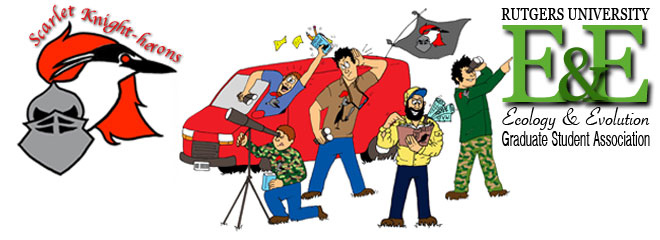The Scarlet Knight-Herons have completed their third World Series of Birding!
We competed in both the Carbon Footprint (only walking and biking) and Cape Island Cup (birding on Cape Island south of the canal) categories. We managed to log over 43 miles in the limited geographic area south of the Cape May Canal, and finished the day with 104 different species of birds seen and/or heard.
Our first bird of the big day was an Eastern Screech Owl calling at midnight - a pretty exciting start! For the next four hours, we biked more than 10 miles and added a grand total of 3 birds (not counting all of the mockingbird imitations). We were also asked by a drunken resident if we were forming a militia, and if he could join us - that has to count for something, right? Finally, as dawn approached, the Meadows started to produce some new birds. Virginia Rail and Common Moorhen finally called after more than an hour of waiting. Yellow-Breasted Chat, Killdeer and American Oystercatchers began to vocalize, and eventually swallows and martins began their morning activities. We headed out to dunes and eventually the beach, spotting gulls, a Northern Gannet, Sanderlings, and a number of other species.
From the Meadows we headed north to New England Road. Birding our way to Higbee Beach Wildlife Management Area, we saw/heard Prairie Warbler, Blackpoll Warbler, Baltimore Oriole, Orchard Oriole, Bald Eagle, Black-and-White Warbler, and Blue Grosbeak. The fields at Higbee produced a Ruby-Throated Hummingbird, Indigo Buntings, a Blue-Headed Vireo, and finally a Veery singing deep in the woods.
Pond Creek Marsh was our next stop, where we identified a Boat-Tailed Grackle as well as a Belted Kingfisher flying over just as we were about to leave. The next leg of our route took us on a long ride across the island to the eastern tip - the Coast Guard Station. Here we added Brant, Red Knot, Bonaparte's Gull, and Common Loon to our list. Finally, after mid-day, we had a trio of American Goldfinch fly into a tree on the side of the road.
The cloudy skies began to produce some precipitation, so we made a lunch a bit longer than we normally would have. The rain never became a downpour, though, so we set out back to the western side of the island to continue birding. We quickly stopped at the 2nd Ave jetty to search for the Glaucous Gull seen earlier in the week, but it was nowhere to be found. We'd have to be happy with the Surf Scoter we added.
Instead of scanning for raptors at Stevens Street, we decided instead to search for birds around Lily Lake. It turned out to be a wise decision, as we found Northern Parula, Northern Waterthrush, Great Blue Heron, and Eastern Towhee. Magnola Warbler was spotted briefly, but only by one team member. We couldn't count it on our final list. We could, however, count the Parasitic Jaegers found off the coast at the St. Peter's dune crossing. At one point we had five individual jaegers harassing a Laughing Gull! It was quite a spectacle.
The Cape May Point State Park produced our only Ring-Billed Gull of the day, as well as American Coot. We decided to end the day at the Meadows, again scanning the ocean and dunes for birds. Finally, exhausted, we headed to the finish line to hand in our final tally.
Southeast winds made the island a difficult place to find migrants, and our total of 104 species was not the only low count of the day. The winners of the Cape Island Cup, Crazy Monkey's Bird Collection Team, had a total of 121 species, the lowest ever for a winning Cape Island Cup team.
More importantly than the number of birds tallied, we were able to raise money for conservation and graduate research, have a good time with great people, and in some small way honor our late teammate, Charlie Kontos.
Thank you to everyone who supported us! We hope to be back again next year!
The Scarlet Knight-Herons
Bill Lynch, David La Puma, Ben Baiser, and Blake Mathys
Subscribe to:
Posts (Atom)


